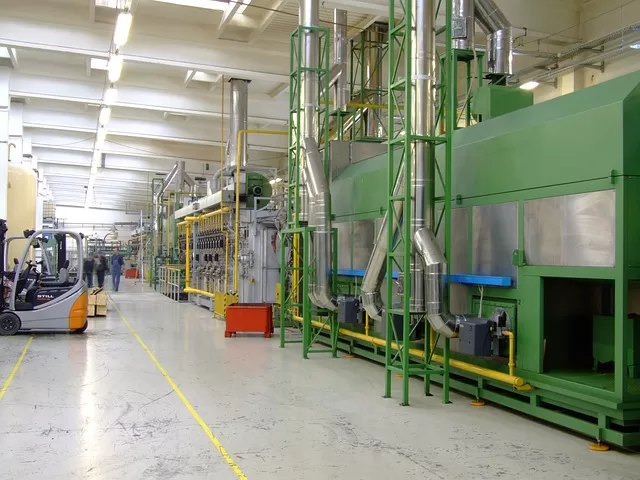Key Aspects Of Asset Operational Performance Audits.
In asset-intensive industrial companies, efficient, safe, and cost-effective asset utilisation is critical to operational excellence.
As such, Auditing asset operational performance is critical to achieving these objectives.
The primary goal of such audits is to determine whether assets are managed and used in a way that maximises value while minimising risks and costs.
This process entails a thorough examination of several critical aspects, including asset maintenance, usage patterns, and overall lifecycle management.
Auditors consider a variety of factors when evaluating asset performance. They scrutinise maintenance schedules and procedures to ensure that regular maintenance is carried out to avoid unexpected breakdowns.
Furthermore, analysing usage patterns helps identify any inefficiencies or underutilization of assets, which can result in unnecessary operational costs.
Effective lifecycle management, which includes procurement, operation, and disposal, is also a critical area of focus, ensuring that assets not only perform optimally but also contribute to the company’s long-term strategic objectives.
Furthermore, safety and compliance are essential parts of the auditing process. Auditors investigate adherence to safety protocols and regulatory requirements in order to reduce the risk of accidents and legal consequences.
This point is especially important in high-risk industries where the failure of a single asset can have disastrous consequences.
Overall, auditing asset operational performance provides a thorough assessment of how well an organisation manages its resources.
This not only aids in identifying areas for improvement, but it also facilitates informed decision-making in order to improve operational efficiency, safety, and cost effectiveness.
As asset-intensive industries evolve, the value of regular and thorough audits cannot be overstated, as they serve as the foundation for long-term operational success and competitive advantage.
Utilization Rates: Assessing Asset Usage.
Assessing asset utilization rates is a critical component of auditing asset operational performance.
Asset utilization rates offer insights into how effectively an asset is being employed relative to its full potential capacity. This evaluation assists auditors in identifying inefficiencies and optimizing asset management strategies.
Several methodologies exist for measuring utilization rates. One common approach is to calculate the ratio of actual operating hours to the total available hours for an asset.
This ratio, often expressed as a percentage, indicates how much of the asset’s potential is being utilized.
For instance, if an asset is operational for 200 hours out of a possible 300 hours, the utilization rate would be approximately 66.67%.
Another technique involves analyzing production output relative to the asset’s maximum output capacity, providing a more nuanced understanding of performance efficiency.
Various factors can affect utilization rates, including maintenance schedules, production demands, and operational downtime.
Regular maintenance, while necessary for asset longevity, can temporarily reduce utilization rates.
Conversely, high production demands may lead to increased usage but can also result in accelerated wear and tear, potentially compromising long-term performance.
Operational downtime, whether planned or unplanned, directly impacts the overall utilization rate, underscoring the importance of effective scheduling and contingency planning.
Under-utilization and over-utilization each have distinct implications for asset performance.
Under-utilization may indicate that an asset is not being used to its full potential, leading to inefficiencies and increased costs per unit of output.
On the other hand, over-utilization can result in excessive strain on the asset, escalating maintenance needs, and shortening its operational lifespan.
Therefore, maintaining an optimal balance is essential for sustaining asset performance and achieving operational efficiency.
Ultimately, the assessment of utilization rates is a pivotal aspect of auditing in asset-intensive industrial companies.
Through meticulous measurement and analysis, auditors can identify patterns, diagnose issues, and recommend strategies for enhancing asset utilization, thereby supporting the overall operational goals of the organization.
Output Quality: Ensuring Expected Production Standards.
In asset-intensive industrial companies, maintaining high output quality is paramount. Auditors play a crucial role in assessing whether the assets are producing goods that meet the expected quality standards.
This involves a comprehensive evaluation of various quality metrics, testing procedures, and an understanding of the repercussions that subpar quality can have on the business.
Quality metrics are essential in measuring the effectiveness of an asset’s performance. Common metrics include defect rates, which measure the percentage of defective items produced, and yield rates, which indicate the proportion of products that meet quality criteria.
Other important metrics include Mean Time Between Failures (MTBF) and Mean Time to Repair (MTTR), which help in understanding the reliability and maintainability of the assets.
Testing procedures are equally important in ensuring output quality. Auditors need to verify that proper testing protocols are in place and consistently followed.
This may involve random sampling, where a subset of products is tested to assess overall quality, or more comprehensive testing regimes that examine every unit produced.
Advanced testing techniques, such as non-destructive testing (NDT) or automated quality inspection systems, can also be employed to ensure precision and accuracy.
The implications of poor quality on the business can be significant. Substandard output can lead to increased rework and scrap rates, which escalate production costs and reduce overall efficiency.
Moreover, consistent quality issues can harm the company’s reputation, leading to customer dissatisfaction and potential loss of business. In some cases, regulatory penalties may also be imposed if the output fails to meet industry standards.
Thus, it is imperative for auditors to diligently assess and ensure that assets are meeting the expected production standards.
By meticulously evaluating quality metrics and testing procedures, auditors help safeguard the company’s reputation and financial health, ensuring that the output remains at the highest possible quality.
Downtime Analysis: Tracking Unplanned Outages.
In asset-intensive industrial companies, unplanned downtime can significantly impact operational performance. Tracking and analyzing unplanned outages is crucial for maintaining high efficiency and productivity.
Auditors play a vital role in this process by meticulously collecting data on the frequency and duration of downtime incidents.
This data provides a clear picture of how often and for how long assets are unavailable, which can directly affect production schedules, delivery timelines, and overall financial performance.
Understanding the root causes of unplanned downtime is the next critical step. Identifying these causes requires a thorough examination of various factors, such as equipment failure, human error, and process inefficiencies.
By conducting detailed analyses, auditors can pinpoint the underlying issues that lead to unplanned outages. This understanding is essential for developing targeted corrective actions that address the specific problems contributing to downtime.
Assessing the effectiveness of corrective actions is also a key component of downtime analysis. Auditors must evaluate whether the measures implemented to reduce unplanned downtime are successful in mitigating the issues identified.
This involves reviewing maintenance records, operational logs, and performance metrics to determine if there has been a noticeable improvement in asset reliability and availability.
Effective corrective actions should lead to a reduction in the frequency and duration of unplanned outages, ultimately enhancing operational performance.
Furthermore, tracking unplanned downtime allows companies to implement predictive maintenance strategies.
By analyzing historical data and identifying patterns, auditors can help forecast potential failures before they occur.
This proactive approach can significantly reduce the occurrence of unplanned outages, as maintenance can be scheduled during planned downtime, minimizing the impact on production.
Tracking unplanned downtime is an essential practice for asset-intensive industrial companies. Through diligent data collection, root cause analysis, and assessment of corrective actions, auditors can provide valuable insights that help minimize unplanned outages.
This, in turn, leads to improved operational performance, increased asset reliability, and a stronger bottom line.
Energy Efficiency: Evaluating Optimal Energy Use.
Evaluating energy efficiency is a critical component of auditing asset operational performance in asset-intensive industrial companies.
Effective energy management not only contributes to cost savings but also enhances environmental sustainability.
Auditors must employ a range of methods to measure energy efficiency accurately, identify inefficiencies, and recommend improvements.
One of the primary methods for measuring energy efficiency is through the use of energy audits. These audits involve a comprehensive analysis of energy consumption patterns across various assets.
Auditors can utilize advanced metering infrastructure (AMI) to gather real-time data on energy use, which helps in pinpointing areas of excessive consumption.
Additionally, benchmarking against industry standards allows auditors to evaluate whether an asset’s energy use is within acceptable limits.
Another significant aspect is the identification of areas where energy consumption can be reduced.
This involves assessing the performance of machinery, equipment, and processes to discover inefficiencies. For instance, older equipment may consume more energy than newer, more efficient models.
Regular maintenance and timely upgrades can lead to substantial energy savings. Implementing energy management systems (EMS) can also optimize energy use by automating and controlling energy-consuming processes.
Improving energy efficiency brings numerous benefits. From an economic standpoint, reduced energy consumption translates into lower operational costs, directly impacting the bottom line.
Energy efficiency measures can also extend the life of equipment, reducing the need for frequent replacements and associated costs.
Environmentally, decreasing energy use reduces the carbon footprint of industrial operations, contributing to global efforts to combat climate change.
Assessing and improving energy efficiency is vital for asset-intensive industrial companies.
By leveraging energy audits, advanced metering, and energy management systems, auditors can ensure that assets are consuming energy optimally, leading to significant cost savings and environmental benefits.
Maintenance Records: Verifying Preventive Maintenance.
The accuracy and comprehensiveness of maintenance records are paramount. These records serve as a cornerstone in verifying that preventive maintenance schedules are adhered to meticulously.
Auditors play a critical role in examining these records, ensuring that scheduled maintenance activities are executed as planned.
The verification process involves cross-checking documented maintenance activities against established schedules and manufacturer recommendations.
This thorough scrutiny helps in identifying any discrepancies or lapses in the maintenance routine.
Properly maintained records provide a chronological history of all maintenance activities, allowing auditors to evaluate the effectiveness of the maintenance practices implemented.
By analyzing these records, auditors can ascertain whether preventive maintenance is not only performed regularly but also executed to a standard that ensures operational efficiency.
This evaluation extends to assessing the impact of maintenance practices on the longevity and performance of industrial assets.
Regular and effective preventive maintenance can significantly reduce the likelihood of unexpected breakdowns, thereby enhancing asset reliability and operational uptime.
Moreover, accurate maintenance records enable a data-driven approach to asset management.
They allow for trend analysis, helping companies to predict potential failures and schedule timely maintenance interventions.
This proactive maintenance strategy is essential for optimizing asset performance and extending the useful life of equipment.
Consequently, well-documented maintenance records not only support compliance with industry regulations but also contribute to the overall economic efficiency of industrial operations.
The verification of preventive maintenance through meticulous record-keeping is crucial for the sustained performance and longevity of assets in industrial settings.
Auditors must ensure that these records are maintained with precision to facilitate an effective evaluation of maintenance practices.
This, in turn, helps in achieving operational excellence and minimizing downtime, thus bolstering the overall productivity of asset-intensive industrial companies.
Operational Costs: Comparing to Budget and Industry Standards.
Evaluating operational costs is a critical component of auditing asset operational performance.
To ensure an accurate assessment, auditors must compare these costs against both budget projections and industry standards.
This involves a comprehensive cost analysis to identify any discrepancies and understand their financial implications.
Cost analysis techniques play a pivotal role in this process. One common approach is variance analysis, which involves comparing actual costs to budgeted amounts and analyzing the differences.
Variances can be categorized into favorable or unfavorable, depending on whether the actual costs are lower or higher than the budgeted costs.
By examining these variances, auditors can pinpoint specific areas where cost control measures may be necessary.
Another technique is benchmarking, which entails comparing the company’s operational costs to those of similar organizations within the industry.
This helps in understanding whether the company’s costs are aligned with industry norms and identifying best practices that could be adopted.
For instance, if an industrial company’s maintenance costs are significantly higher than the industry average, this could indicate inefficiencies or areas where cost savings could be achieved.
It is also essential to conduct a trend analysis, which involves examining cost patterns over time. This helps auditors to understand whether operational costs are increasing, decreasing, or remaining stable.
Identifying trends can provide insights into potential long-term financial impacts and help in forecasting future budget requirements.
Understanding the financial implications of operational performance is crucial for making informed decisions.
Discrepancies between actual costs and budget projections can affect profitability and financial stability.
By identifying the root causes of these discrepancies, auditors can provide actionable recommendations to management, such as optimizing asset utilization, improving maintenance procedures, or renegotiating supplier contracts.
A thorough evaluation of operational costs compared to budget and industry standards is essential for assessing the financial health of asset-intensive industrial companies.
Employing effective cost analysis techniques and understanding the broader financial implications can lead to more informed decision-making and improved operational performance.
Safety Performance: Assessing Incident and Near-Miss Records.
Safety performance is a pivotal component of overall asset performance and auditing safety incident and near-miss records is essential to ensure that the operational environment remains secure and efficient.
Safety performance is typically measured using several indicators, including the frequency and severity of incidents, the number of near-misses, and compliance with safety regulations and standards.
When reviewing safety incident records, auditors should meticulously analyze data related to reported accidents, injuries, and equipment failures.
This includes examining the root causes of incidents, the corrective actions taken, and the timeframes within which these actions were implemented.
A detailed examination of near-miss records is equally important, as these events often serve as early warning signals for potential future incidents.
Understanding the circumstances under which near-misses occurred can help in identifying patterns and areas that require immediate attention.
The importance of maintaining a safe operating environment cannot be overstated. A robust safety culture not only protects the workforce but also enhances overall operational efficiency.
Companies that prioritize safety tend to experience fewer disruptions, lower maintenance costs, and increased employee morale and productivity.
Moreover, adherence to safety standards can prevent costly regulatory fines and litigations, further contributing to the financial health of the organization.
Auditors must also assess the effectiveness of safety training programs and emergency preparedness plans. Ensuring that employees are well-trained and that emergency protocols are regularly updated and rehearsed can significantly mitigate the risks associated with asset operations.
Additionally, the implementation of advanced safety technologies, such as real-time monitoring systems and predictive analytics, can provide valuable insights and enhance proactive risk management.
The assessment of safety performance through the review of incident and near-miss records is a critical aspect of auditing asset operational performance.
A thorough and systematic approach to evaluating safety measures can lead to substantial improvements in both safety and operational efficiency, thereby ensuring the long-term success of asset-intensive industrial companies.
Learning To Become An Auditor In This Area.
To become a competent auditor in asset operational performance, an individual would typically need a combination of education, training, and experience. Here are some key areas of study and development:
Educational background.
1. Engineering degree (mechanical, electrical, industrial, or related field).
2. Business administration or finance degree.
3. Asset management-specific qualifications.
Professional certifications.
1. Certified Maintenance & Reliability Professional (CMRP).
2. Certified Asset Management Assessor (CAMA).
3. ISO 55000 Certified Assessor.
Technical training.
1. Asset management principles and practices.
2. Reliability engineering.
3. Maintenance strategies and techniques.
Financial skills.
1. Cost analysis and budgeting.
2. Life cycle costing.
3. Financial modeling for asset management.
Auditing skills.
1. General auditing principles and practices.
2. Specific asset performance auditing techniques.
3. Report writing and presentation skills.
Industry-specific knowledge.
Internal Company Courses or training in the particular industry (e.g., manufacturing, utilities, oil and gas)
Data analysis and technology.
1. Data analytics and statistics.
2. Asset management software systems.
3. Industrial Internet of Things (IIoT) and predictive analytics.
Soft skills/Personal Attributes development.
1. Communication and interpersonal skills.
2. Problem-solving and critical thinking.
3. Project management.
Continuous professional development.
1. Attending industry conferences and workshops.
2. Staying updated with latest trends and best practices.
Practical experience.
1. On-the-job training or internships in asset-intensive industries.
2. Shadowing experienced auditors.
In conclusion.
The auditing of asset operational performance is not just a compliance exercise, but a critical business practice that drives operational excellence, financial performance and long-term sustainability and is well emphasized by the following key points:.
1. Strategic value: Auditing asset performance provides crucial insights that inform strategic decision-making, helping companies optimize their investments and operations.
2. Financial impact: Understanding asset performance through auditing can lead to significant cost savings, improved efficiency, and better resource allocation.
3. Risk management: Regular audits help identify potential issues before they become critical, reducing the risk of unexpected failures or downtime.
4. Compliance assurance: Audits ensure that assets are operating in compliance with regulatory requirements and industry standards.
5. Continuous improvement: The audit process drives ongoing enhancement of asset management practices, leading to better overall performance over time.
6. Data-driven decisions: Audits provide objective data that supports evidence-based decision-making across the organization.
7. Lifecycle optimization: Understanding asset performance helps in making informed decisions about maintenance, upgrades, or replacements, optimizing the asset’s entire lifecycle.
8. Competitive advantage: Companies that excel in asset performance management often gain a significant edge over their competitors in terms of efficiency and reliability.
9. Sustainability: Effective asset management through auditing can contribute to more sustainable operations by optimizing resource use and reducing waste.
10. Stakeholder confidence: Demonstrating good asset management practices through regular audits can boost confidence among investors, regulators, and customers.
Auditing asset operational performance is an essential practice that should be done at least once every year in my opinion.
It provides businesses with valuable insights into their operations while also promoting financial optimisation and strategic decision-making.
Routine audits provide a comprehensive understanding of asset performance can help businesses reduce risks, ensure compliance, and seize opportunities for ongoing innovation and improvement.
Personally, I believe that external annual audits of asset operational performance provide businesses with the most reliable and solid data, as well as an emotionally detached assessment of their operations.
An impartial comprehensive assessment yields reliable data, unbiased results, and valuable insights into improvement opportunities.
By leveraging external expertise, companies can gain a fresh perspective on their asset performance, helping them stay current with best practices and continuously enhance their operations.
Finally, this comprehensive approach to asset management not only improves financial performance and operational efficiency, but also positions the company for long-term success and sustainability in an increasingly competitive market.








